Global Business Environment: Ella's Kitchen Expansion Strategies
VerifiedAdded on 2023/03/20
|11
|4263
|91
Report
AI Summary
This report examines the global business environment through the lens of Ella's Kitchen, a company specializing in organic baby food. It analyzes key factors driving global commerce, including cost, market, competition, and environmental considerations. The report delves into the complexities of strategic challenges faced by organizations, focusing on the importance of understanding cultural nuances and adapting to local market demands. It further explores the impact of globalization on organizational leadership, governance, structure, culture, and function, emphasizing the need for ethical and sustainable business practices. Different decision-making processes are also discussed. The report then investigates various routes to internationalization, outlining key barriers and providing insights into how companies can navigate the global landscape successfully. The report also highlights the importance of understanding cultural differences and ethical considerations in international business.
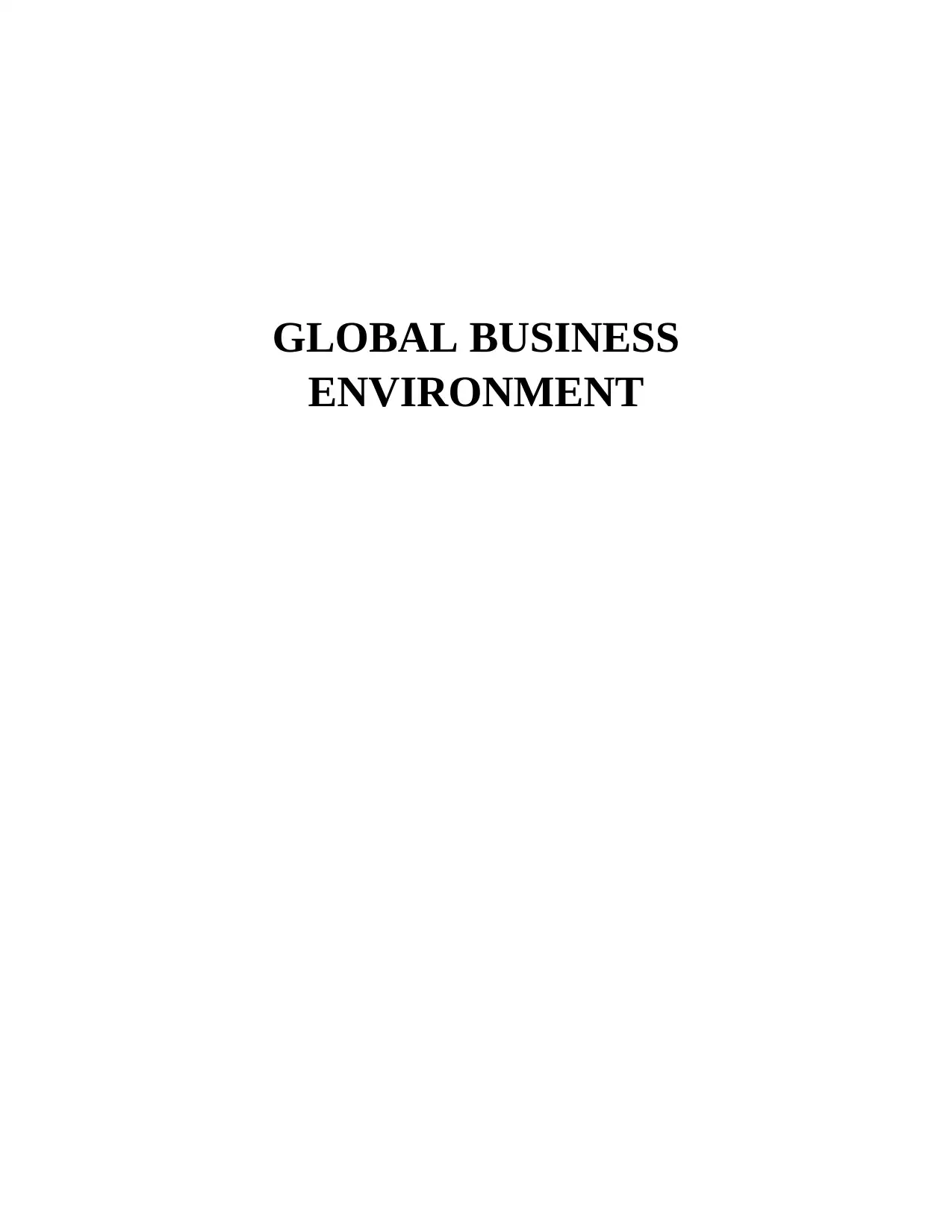
GLOBAL BUSINESS
ENVIRONMENT
ENVIRONMENT
Paraphrase This Document
Need a fresh take? Get an instant paraphrase of this document with our AI Paraphraser

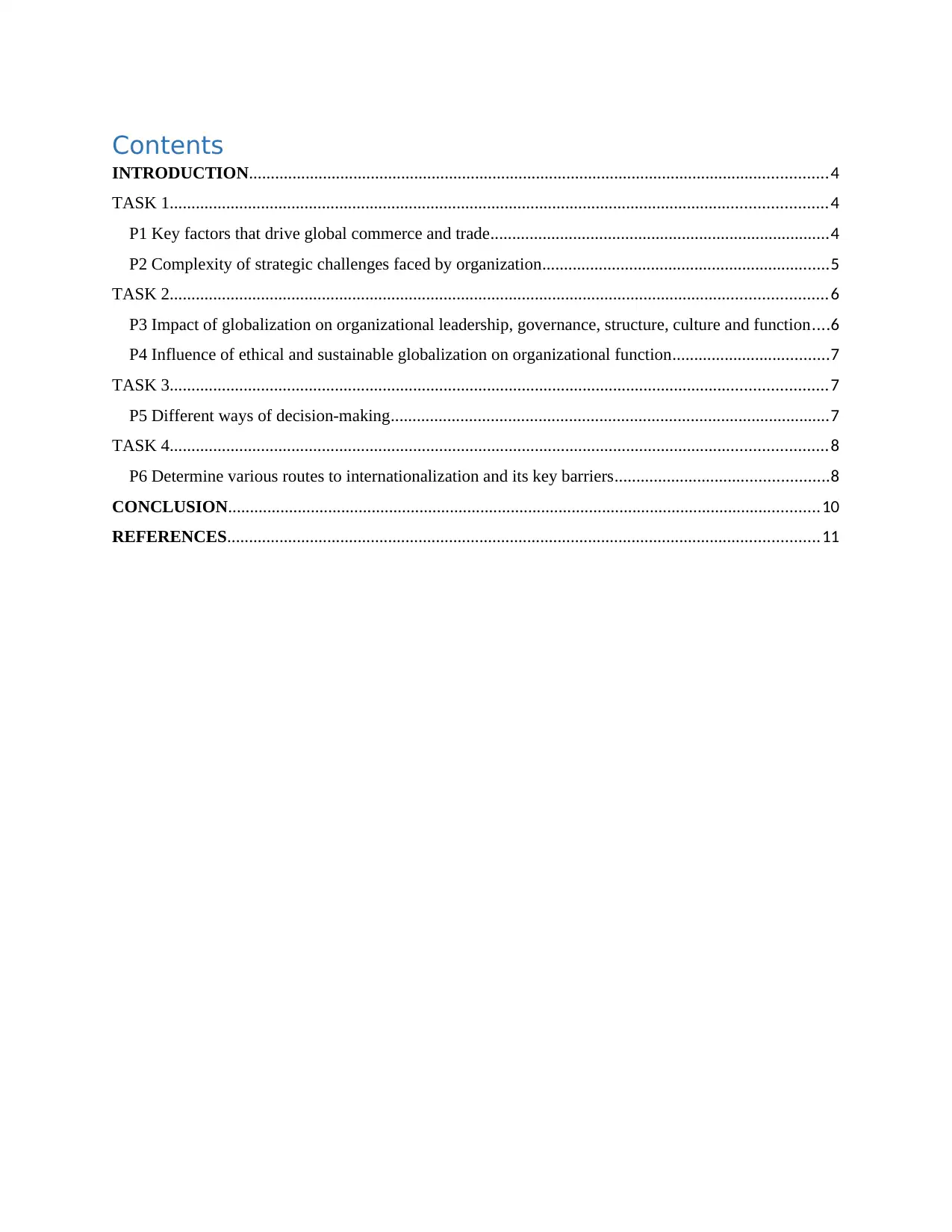
Contents
INTRODUCTION.....................................................................................................................................4
TASK 1.......................................................................................................................................................4
P1 Key factors that drive global commerce and trade..............................................................................4
P2 Complexity of strategic challenges faced by organization..................................................................5
TASK 2.......................................................................................................................................................6
P3 Impact of globalization on organizational leadership, governance, structure, culture and function....6
P4 Influence of ethical and sustainable globalization on organizational function....................................7
TASK 3.......................................................................................................................................................7
P5 Different ways of decision-making.....................................................................................................7
TASK 4.......................................................................................................................................................8
P6 Determine various routes to internationalization and its key barriers.................................................8
CONCLUSION........................................................................................................................................10
REFERENCES........................................................................................................................................11
INTRODUCTION.....................................................................................................................................4
TASK 1.......................................................................................................................................................4
P1 Key factors that drive global commerce and trade..............................................................................4
P2 Complexity of strategic challenges faced by organization..................................................................5
TASK 2.......................................................................................................................................................6
P3 Impact of globalization on organizational leadership, governance, structure, culture and function....6
P4 Influence of ethical and sustainable globalization on organizational function....................................7
TASK 3.......................................................................................................................................................7
P5 Different ways of decision-making.....................................................................................................7
TASK 4.......................................................................................................................................................8
P6 Determine various routes to internationalization and its key barriers.................................................8
CONCLUSION........................................................................................................................................10
REFERENCES........................................................................................................................................11
⊘ This is a preview!⊘
Do you want full access?
Subscribe today to unlock all pages.

Trusted by 1+ million students worldwide
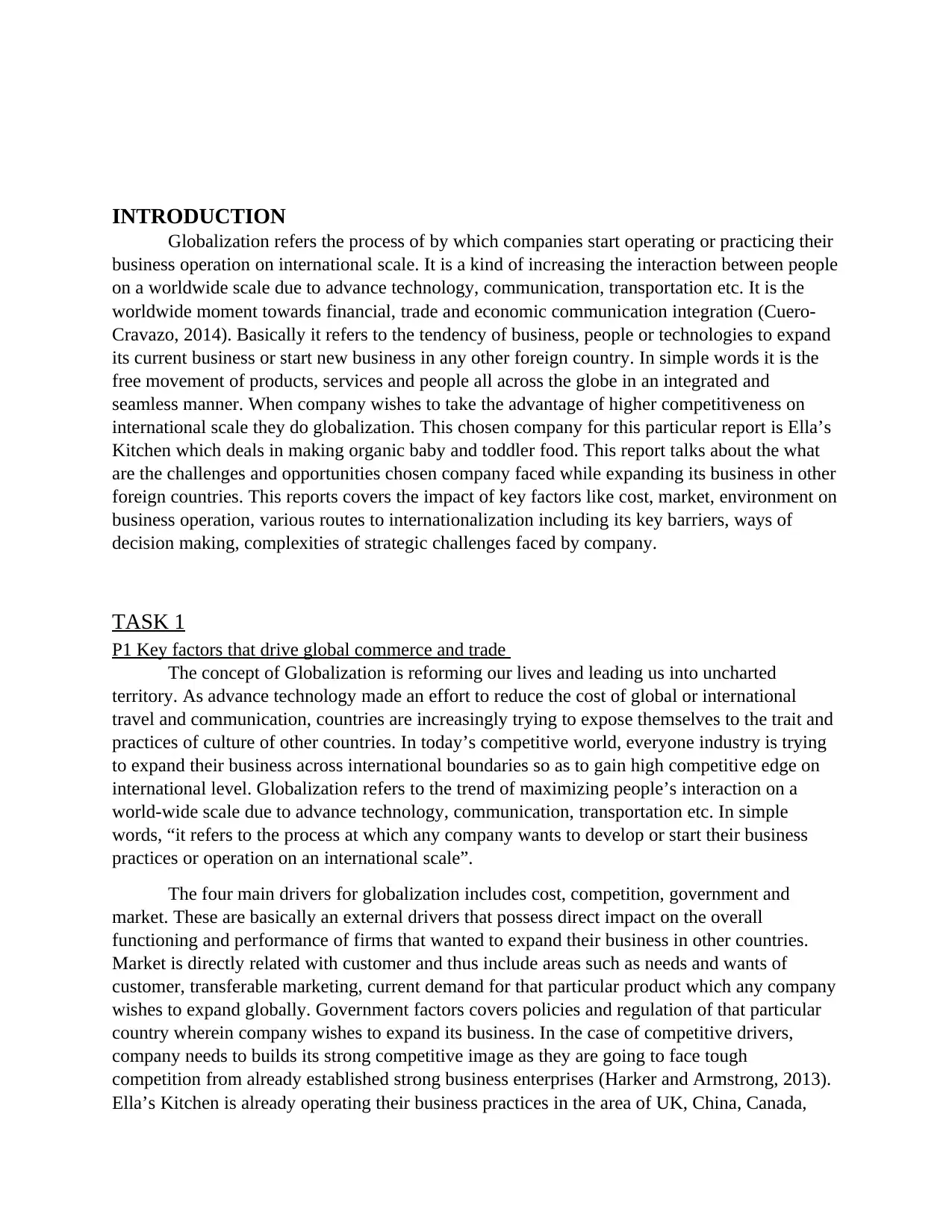
INTRODUCTION
Globalization refers the process of by which companies start operating or practicing their
business operation on international scale. It is a kind of increasing the interaction between people
on a worldwide scale due to advance technology, communication, transportation etc. It is the
worldwide moment towards financial, trade and economic communication integration (Cuero-
Cravazo, 2014). Basically it refers to the tendency of business, people or technologies to expand
its current business or start new business in any other foreign country. In simple words it is the
free movement of products, services and people all across the globe in an integrated and
seamless manner. When company wishes to take the advantage of higher competitiveness on
international scale they do globalization. This chosen company for this particular report is Ella’s
Kitchen which deals in making organic baby and toddler food. This report talks about the what
are the challenges and opportunities chosen company faced while expanding its business in other
foreign countries. This reports covers the impact of key factors like cost, market, environment on
business operation, various routes to internationalization including its key barriers, ways of
decision making, complexities of strategic challenges faced by company.
TASK 1
P1 Key factors that drive global commerce and trade
The concept of Globalization is reforming our lives and leading us into uncharted
territory. As advance technology made an effort to reduce the cost of global or international
travel and communication, countries are increasingly trying to expose themselves to the trait and
practices of culture of other countries. In today’s competitive world, everyone industry is trying
to expand their business across international boundaries so as to gain high competitive edge on
international level. Globalization refers to the trend of maximizing people’s interaction on a
world-wide scale due to advance technology, communication, transportation etc. In simple
words, “it refers to the process at which any company wants to develop or start their business
practices or operation on an international scale”.
The four main drivers for globalization includes cost, competition, government and
market. These are basically an external drivers that possess direct impact on the overall
functioning and performance of firms that wanted to expand their business in other countries.
Market is directly related with customer and thus include areas such as needs and wants of
customer, transferable marketing, current demand for that particular product which any company
wishes to expand globally. Government factors covers policies and regulation of that particular
country wherein company wishes to expand its business. In the case of competitive drivers,
company needs to builds its strong competitive image as they are going to face tough
competition from already established strong business enterprises (Harker and Armstrong, 2013).
Ella’s Kitchen is already operating their business practices in the area of UK, China, Canada,
Globalization refers the process of by which companies start operating or practicing their
business operation on international scale. It is a kind of increasing the interaction between people
on a worldwide scale due to advance technology, communication, transportation etc. It is the
worldwide moment towards financial, trade and economic communication integration (Cuero-
Cravazo, 2014). Basically it refers to the tendency of business, people or technologies to expand
its current business or start new business in any other foreign country. In simple words it is the
free movement of products, services and people all across the globe in an integrated and
seamless manner. When company wishes to take the advantage of higher competitiveness on
international scale they do globalization. This chosen company for this particular report is Ella’s
Kitchen which deals in making organic baby and toddler food. This report talks about the what
are the challenges and opportunities chosen company faced while expanding its business in other
foreign countries. This reports covers the impact of key factors like cost, market, environment on
business operation, various routes to internationalization including its key barriers, ways of
decision making, complexities of strategic challenges faced by company.
TASK 1
P1 Key factors that drive global commerce and trade
The concept of Globalization is reforming our lives and leading us into uncharted
territory. As advance technology made an effort to reduce the cost of global or international
travel and communication, countries are increasingly trying to expose themselves to the trait and
practices of culture of other countries. In today’s competitive world, everyone industry is trying
to expand their business across international boundaries so as to gain high competitive edge on
international level. Globalization refers to the trend of maximizing people’s interaction on a
world-wide scale due to advance technology, communication, transportation etc. In simple
words, “it refers to the process at which any company wants to develop or start their business
practices or operation on an international scale”.
The four main drivers for globalization includes cost, competition, government and
market. These are basically an external drivers that possess direct impact on the overall
functioning and performance of firms that wanted to expand their business in other countries.
Market is directly related with customer and thus include areas such as needs and wants of
customer, transferable marketing, current demand for that particular product which any company
wishes to expand globally. Government factors covers policies and regulation of that particular
country wherein company wishes to expand its business. In the case of competitive drivers,
company needs to builds its strong competitive image as they are going to face tough
competition from already established strong business enterprises (Harker and Armstrong, 2013).
Ella’s Kitchen is already operating their business practices in the area of UK, China, Canada,
Paraphrase This Document
Need a fresh take? Get an instant paraphrase of this document with our AI Paraphraser
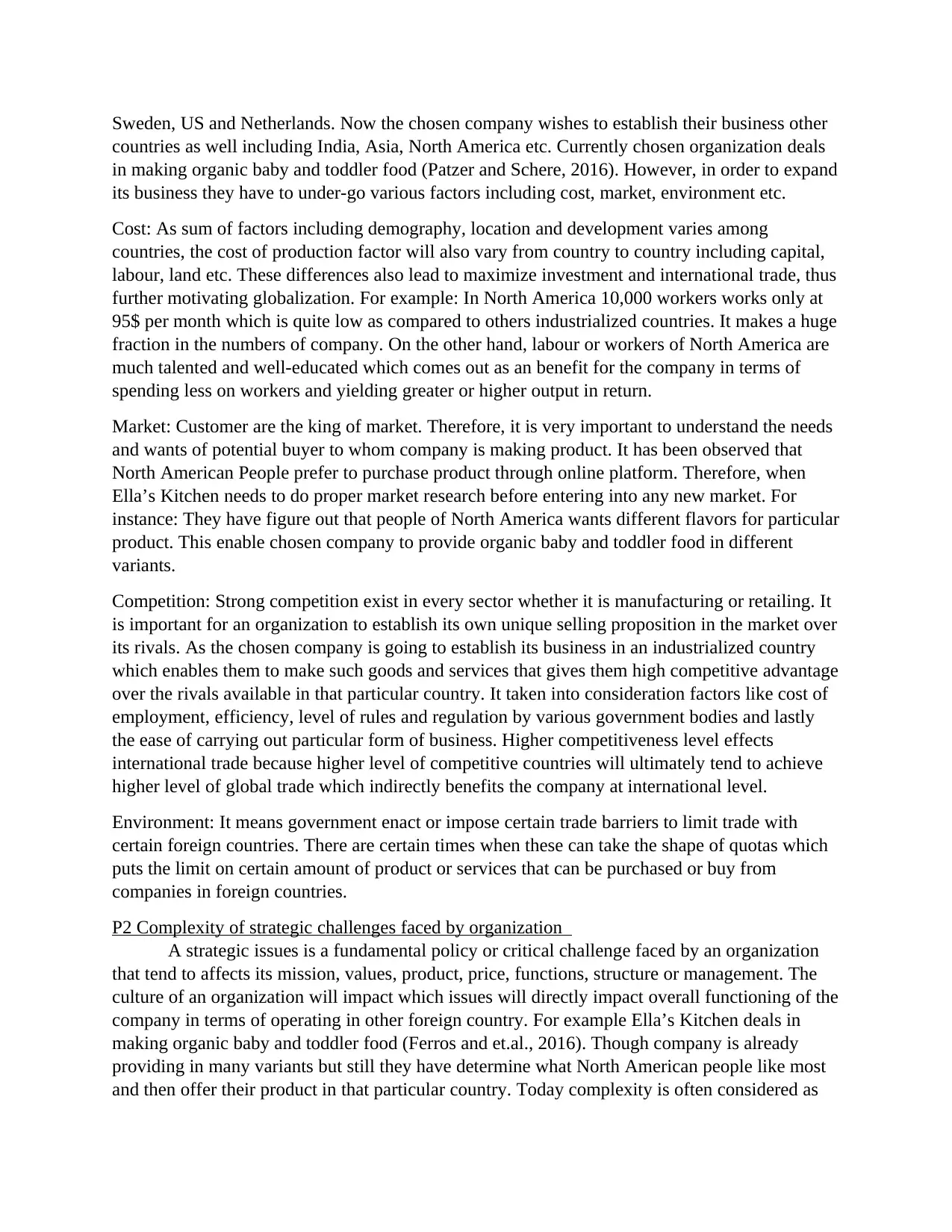
Sweden, US and Netherlands. Now the chosen company wishes to establish their business other
countries as well including India, Asia, North America etc. Currently chosen organization deals
in making organic baby and toddler food (Patzer and Schere, 2016). However, in order to expand
its business they have to under-go various factors including cost, market, environment etc.
Cost: As sum of factors including demography, location and development varies among
countries, the cost of production factor will also vary from country to country including capital,
labour, land etc. These differences also lead to maximize investment and international trade, thus
further motivating globalization. For example: In North America 10,000 workers works only at
95$ per month which is quite low as compared to others industrialized countries. It makes a huge
fraction in the numbers of company. On the other hand, labour or workers of North America are
much talented and well-educated which comes out as an benefit for the company in terms of
spending less on workers and yielding greater or higher output in return.
Market: Customer are the king of market. Therefore, it is very important to understand the needs
and wants of potential buyer to whom company is making product. It has been observed that
North American People prefer to purchase product through online platform. Therefore, when
Ella’s Kitchen needs to do proper market research before entering into any new market. For
instance: They have figure out that people of North America wants different flavors for particular
product. This enable chosen company to provide organic baby and toddler food in different
variants.
Competition: Strong competition exist in every sector whether it is manufacturing or retailing. It
is important for an organization to establish its own unique selling proposition in the market over
its rivals. As the chosen company is going to establish its business in an industrialized country
which enables them to make such goods and services that gives them high competitive advantage
over the rivals available in that particular country. It taken into consideration factors like cost of
employment, efficiency, level of rules and regulation by various government bodies and lastly
the ease of carrying out particular form of business. Higher competitiveness level effects
international trade because higher level of competitive countries will ultimately tend to achieve
higher level of global trade which indirectly benefits the company at international level.
Environment: It means government enact or impose certain trade barriers to limit trade with
certain foreign countries. There are certain times when these can take the shape of quotas which
puts the limit on certain amount of product or services that can be purchased or buy from
companies in foreign countries.
P2 Complexity of strategic challenges faced by organization
A strategic issues is a fundamental policy or critical challenge faced by an organization
that tend to affects its mission, values, product, price, functions, structure or management. The
culture of an organization will impact which issues will directly impact overall functioning of the
company in terms of operating in other foreign country. For example Ella’s Kitchen deals in
making organic baby and toddler food (Ferros and et.al., 2016). Though company is already
providing in many variants but still they have determine what North American people like most
and then offer their product in that particular country. Today complexity is often considered as
countries as well including India, Asia, North America etc. Currently chosen organization deals
in making organic baby and toddler food (Patzer and Schere, 2016). However, in order to expand
its business they have to under-go various factors including cost, market, environment etc.
Cost: As sum of factors including demography, location and development varies among
countries, the cost of production factor will also vary from country to country including capital,
labour, land etc. These differences also lead to maximize investment and international trade, thus
further motivating globalization. For example: In North America 10,000 workers works only at
95$ per month which is quite low as compared to others industrialized countries. It makes a huge
fraction in the numbers of company. On the other hand, labour or workers of North America are
much talented and well-educated which comes out as an benefit for the company in terms of
spending less on workers and yielding greater or higher output in return.
Market: Customer are the king of market. Therefore, it is very important to understand the needs
and wants of potential buyer to whom company is making product. It has been observed that
North American People prefer to purchase product through online platform. Therefore, when
Ella’s Kitchen needs to do proper market research before entering into any new market. For
instance: They have figure out that people of North America wants different flavors for particular
product. This enable chosen company to provide organic baby and toddler food in different
variants.
Competition: Strong competition exist in every sector whether it is manufacturing or retailing. It
is important for an organization to establish its own unique selling proposition in the market over
its rivals. As the chosen company is going to establish its business in an industrialized country
which enables them to make such goods and services that gives them high competitive advantage
over the rivals available in that particular country. It taken into consideration factors like cost of
employment, efficiency, level of rules and regulation by various government bodies and lastly
the ease of carrying out particular form of business. Higher competitiveness level effects
international trade because higher level of competitive countries will ultimately tend to achieve
higher level of global trade which indirectly benefits the company at international level.
Environment: It means government enact or impose certain trade barriers to limit trade with
certain foreign countries. There are certain times when these can take the shape of quotas which
puts the limit on certain amount of product or services that can be purchased or buy from
companies in foreign countries.
P2 Complexity of strategic challenges faced by organization
A strategic issues is a fundamental policy or critical challenge faced by an organization
that tend to affects its mission, values, product, price, functions, structure or management. The
culture of an organization will impact which issues will directly impact overall functioning of the
company in terms of operating in other foreign country. For example Ella’s Kitchen deals in
making organic baby and toddler food (Ferros and et.al., 2016). Though company is already
providing in many variants but still they have determine what North American people like most
and then offer their product in that particular country. Today complexity is often considered as
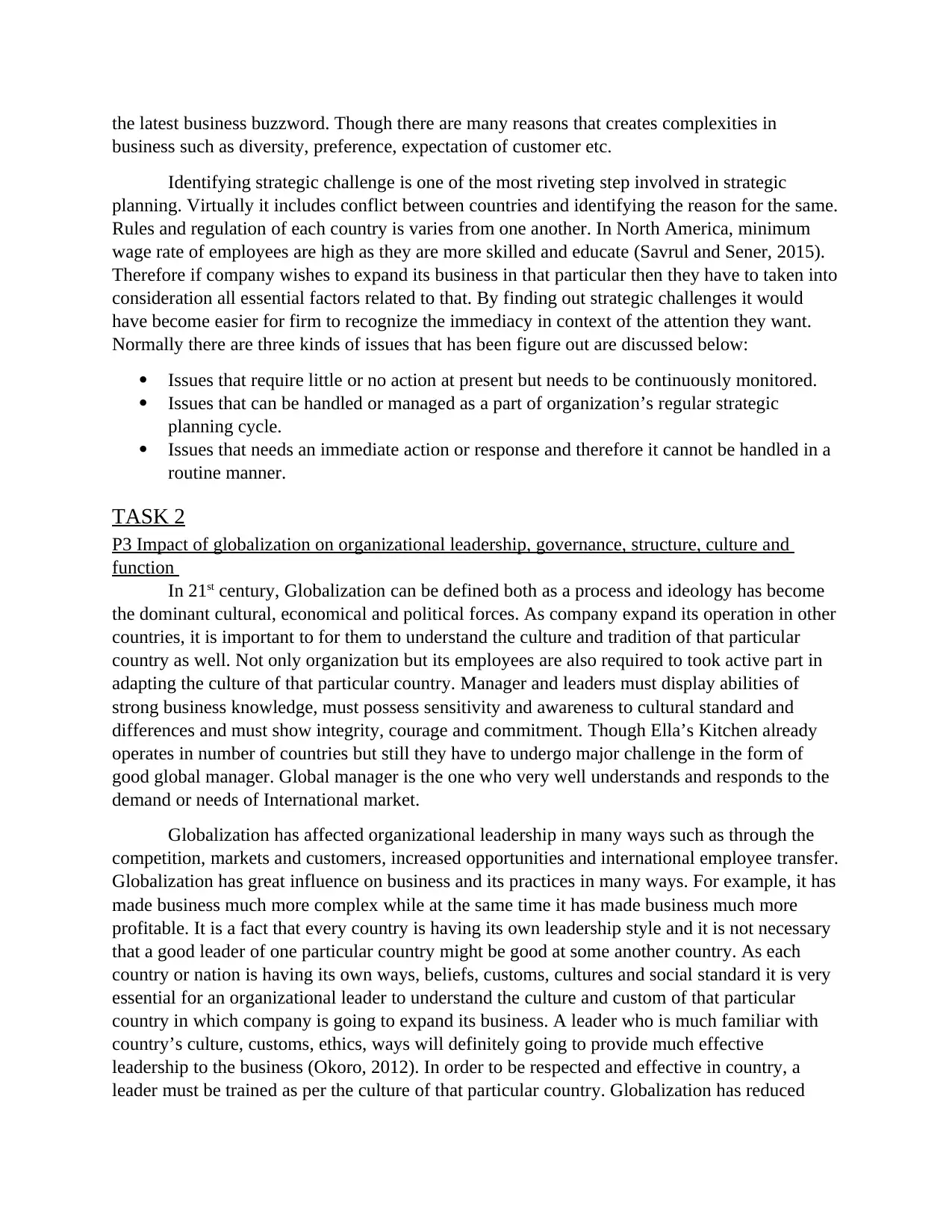
the latest business buzzword. Though there are many reasons that creates complexities in
business such as diversity, preference, expectation of customer etc.
Identifying strategic challenge is one of the most riveting step involved in strategic
planning. Virtually it includes conflict between countries and identifying the reason for the same.
Rules and regulation of each country is varies from one another. In North America, minimum
wage rate of employees are high as they are more skilled and educate (Savrul and Sener, 2015).
Therefore if company wishes to expand its business in that particular then they have to taken into
consideration all essential factors related to that. By finding out strategic challenges it would
have become easier for firm to recognize the immediacy in context of the attention they want.
Normally there are three kinds of issues that has been figure out are discussed below:
Issues that require little or no action at present but needs to be continuously monitored.
Issues that can be handled or managed as a part of organization’s regular strategic
planning cycle.
Issues that needs an immediate action or response and therefore it cannot be handled in a
routine manner.
TASK 2
P3 Impact of globalization on organizational leadership, governance, structure, culture and
function
In 21st century, Globalization can be defined both as a process and ideology has become
the dominant cultural, economical and political forces. As company expand its operation in other
countries, it is important to for them to understand the culture and tradition of that particular
country as well. Not only organization but its employees are also required to took active part in
adapting the culture of that particular country. Manager and leaders must display abilities of
strong business knowledge, must possess sensitivity and awareness to cultural standard and
differences and must show integrity, courage and commitment. Though Ella’s Kitchen already
operates in number of countries but still they have to undergo major challenge in the form of
good global manager. Global manager is the one who very well understands and responds to the
demand or needs of International market.
Globalization has affected organizational leadership in many ways such as through the
competition, markets and customers, increased opportunities and international employee transfer.
Globalization has great influence on business and its practices in many ways. For example, it has
made business much more complex while at the same time it has made business much more
profitable. It is a fact that every country is having its own leadership style and it is not necessary
that a good leader of one particular country might be good at some another country. As each
country or nation is having its own ways, beliefs, customs, cultures and social standard it is very
essential for an organizational leader to understand the culture and custom of that particular
country in which company is going to expand its business. A leader who is much familiar with
country’s culture, customs, ethics, ways will definitely going to provide much effective
leadership to the business (Okoro, 2012). In order to be respected and effective in country, a
leader must be trained as per the culture of that particular country. Globalization has reduced
business such as diversity, preference, expectation of customer etc.
Identifying strategic challenge is one of the most riveting step involved in strategic
planning. Virtually it includes conflict between countries and identifying the reason for the same.
Rules and regulation of each country is varies from one another. In North America, minimum
wage rate of employees are high as they are more skilled and educate (Savrul and Sener, 2015).
Therefore if company wishes to expand its business in that particular then they have to taken into
consideration all essential factors related to that. By finding out strategic challenges it would
have become easier for firm to recognize the immediacy in context of the attention they want.
Normally there are three kinds of issues that has been figure out are discussed below:
Issues that require little or no action at present but needs to be continuously monitored.
Issues that can be handled or managed as a part of organization’s regular strategic
planning cycle.
Issues that needs an immediate action or response and therefore it cannot be handled in a
routine manner.
TASK 2
P3 Impact of globalization on organizational leadership, governance, structure, culture and
function
In 21st century, Globalization can be defined both as a process and ideology has become
the dominant cultural, economical and political forces. As company expand its operation in other
countries, it is important to for them to understand the culture and tradition of that particular
country as well. Not only organization but its employees are also required to took active part in
adapting the culture of that particular country. Manager and leaders must display abilities of
strong business knowledge, must possess sensitivity and awareness to cultural standard and
differences and must show integrity, courage and commitment. Though Ella’s Kitchen already
operates in number of countries but still they have to undergo major challenge in the form of
good global manager. Global manager is the one who very well understands and responds to the
demand or needs of International market.
Globalization has affected organizational leadership in many ways such as through the
competition, markets and customers, increased opportunities and international employee transfer.
Globalization has great influence on business and its practices in many ways. For example, it has
made business much more complex while at the same time it has made business much more
profitable. It is a fact that every country is having its own leadership style and it is not necessary
that a good leader of one particular country might be good at some another country. As each
country or nation is having its own ways, beliefs, customs, cultures and social standard it is very
essential for an organizational leader to understand the culture and custom of that particular
country in which company is going to expand its business. A leader who is much familiar with
country’s culture, customs, ethics, ways will definitely going to provide much effective
leadership to the business (Okoro, 2012). In order to be respected and effective in country, a
leader must be trained as per the culture of that particular country. Globalization has reduced
⊘ This is a preview!⊘
Do you want full access?
Subscribe today to unlock all pages.

Trusted by 1+ million students worldwide
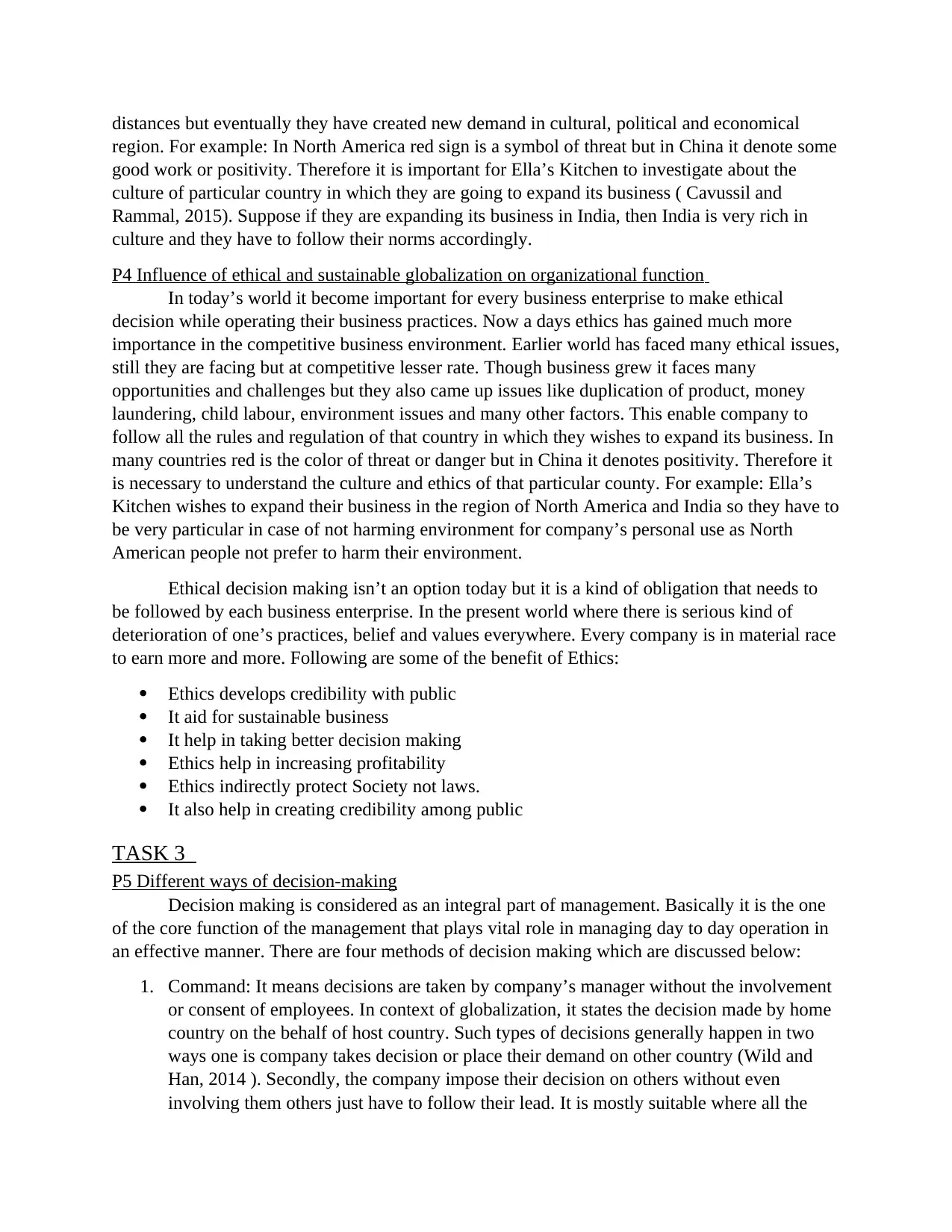
distances but eventually they have created new demand in cultural, political and economical
region. For example: In North America red sign is a symbol of threat but in China it denote some
good work or positivity. Therefore it is important for Ella’s Kitchen to investigate about the
culture of particular country in which they are going to expand its business ( Cavussil and
Rammal, 2015). Suppose if they are expanding its business in India, then India is very rich in
culture and they have to follow their norms accordingly.
P4 Influence of ethical and sustainable globalization on organizational function
In today’s world it become important for every business enterprise to make ethical
decision while operating their business practices. Now a days ethics has gained much more
importance in the competitive business environment. Earlier world has faced many ethical issues,
still they are facing but at competitive lesser rate. Though business grew it faces many
opportunities and challenges but they also came up issues like duplication of product, money
laundering, child labour, environment issues and many other factors. This enable company to
follow all the rules and regulation of that country in which they wishes to expand its business. In
many countries red is the color of threat or danger but in China it denotes positivity. Therefore it
is necessary to understand the culture and ethics of that particular county. For example: Ella’s
Kitchen wishes to expand their business in the region of North America and India so they have to
be very particular in case of not harming environment for company’s personal use as North
American people not prefer to harm their environment.
Ethical decision making isn’t an option today but it is a kind of obligation that needs to
be followed by each business enterprise. In the present world where there is serious kind of
deterioration of one’s practices, belief and values everywhere. Every company is in material race
to earn more and more. Following are some of the benefit of Ethics:
Ethics develops credibility with public
It aid for sustainable business
It help in taking better decision making
Ethics help in increasing profitability
Ethics indirectly protect Society not laws.
It also help in creating credibility among public
TASK 3
P5 Different ways of decision-making
Decision making is considered as an integral part of management. Basically it is the one
of the core function of the management that plays vital role in managing day to day operation in
an effective manner. There are four methods of decision making which are discussed below:
1. Command: It means decisions are taken by company’s manager without the involvement
or consent of employees. In context of globalization, it states the decision made by home
country on the behalf of host country. Such types of decisions generally happen in two
ways one is company takes decision or place their demand on other country (Wild and
Han, 2014 ). Secondly, the company impose their decision on others without even
involving them others just have to follow their lead. It is mostly suitable where all the
region. For example: In North America red sign is a symbol of threat but in China it denote some
good work or positivity. Therefore it is important for Ella’s Kitchen to investigate about the
culture of particular country in which they are going to expand its business ( Cavussil and
Rammal, 2015). Suppose if they are expanding its business in India, then India is very rich in
culture and they have to follow their norms accordingly.
P4 Influence of ethical and sustainable globalization on organizational function
In today’s world it become important for every business enterprise to make ethical
decision while operating their business practices. Now a days ethics has gained much more
importance in the competitive business environment. Earlier world has faced many ethical issues,
still they are facing but at competitive lesser rate. Though business grew it faces many
opportunities and challenges but they also came up issues like duplication of product, money
laundering, child labour, environment issues and many other factors. This enable company to
follow all the rules and regulation of that country in which they wishes to expand its business. In
many countries red is the color of threat or danger but in China it denotes positivity. Therefore it
is necessary to understand the culture and ethics of that particular county. For example: Ella’s
Kitchen wishes to expand their business in the region of North America and India so they have to
be very particular in case of not harming environment for company’s personal use as North
American people not prefer to harm their environment.
Ethical decision making isn’t an option today but it is a kind of obligation that needs to
be followed by each business enterprise. In the present world where there is serious kind of
deterioration of one’s practices, belief and values everywhere. Every company is in material race
to earn more and more. Following are some of the benefit of Ethics:
Ethics develops credibility with public
It aid for sustainable business
It help in taking better decision making
Ethics help in increasing profitability
Ethics indirectly protect Society not laws.
It also help in creating credibility among public
TASK 3
P5 Different ways of decision-making
Decision making is considered as an integral part of management. Basically it is the one
of the core function of the management that plays vital role in managing day to day operation in
an effective manner. There are four methods of decision making which are discussed below:
1. Command: It means decisions are taken by company’s manager without the involvement
or consent of employees. In context of globalization, it states the decision made by home
country on the behalf of host country. Such types of decisions generally happen in two
ways one is company takes decision or place their demand on other country (Wild and
Han, 2014 ). Secondly, the company impose their decision on others without even
involving them others just have to follow their lead. It is mostly suitable where all the
Paraphrase This Document
Need a fresh take? Get an instant paraphrase of this document with our AI Paraphraser
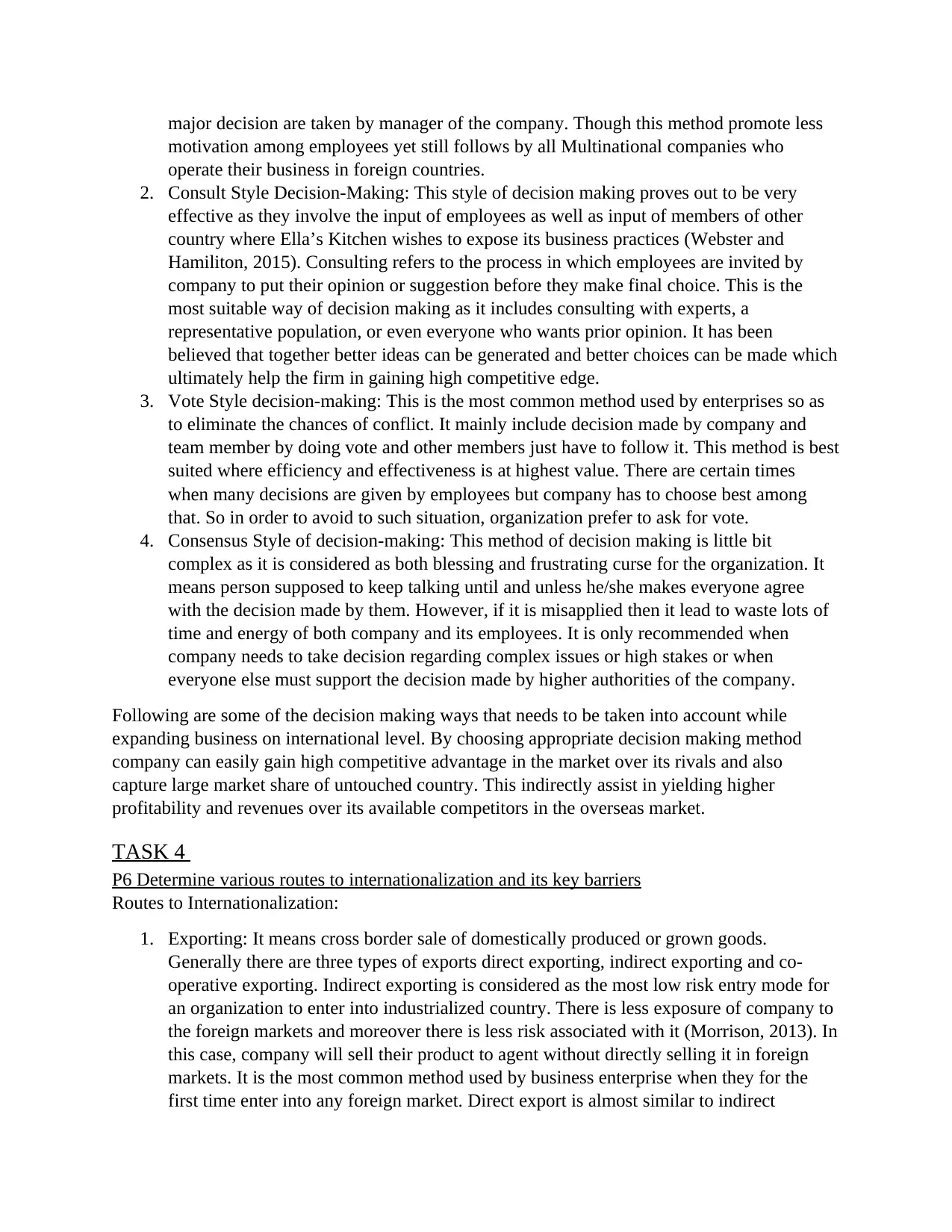
major decision are taken by manager of the company. Though this method promote less
motivation among employees yet still follows by all Multinational companies who
operate their business in foreign countries.
2. Consult Style Decision-Making: This style of decision making proves out to be very
effective as they involve the input of employees as well as input of members of other
country where Ella’s Kitchen wishes to expose its business practices (Webster and
Hamiliton, 2015). Consulting refers to the process in which employees are invited by
company to put their opinion or suggestion before they make final choice. This is the
most suitable way of decision making as it includes consulting with experts, a
representative population, or even everyone who wants prior opinion. It has been
believed that together better ideas can be generated and better choices can be made which
ultimately help the firm in gaining high competitive edge.
3. Vote Style decision-making: This is the most common method used by enterprises so as
to eliminate the chances of conflict. It mainly include decision made by company and
team member by doing vote and other members just have to follow it. This method is best
suited where efficiency and effectiveness is at highest value. There are certain times
when many decisions are given by employees but company has to choose best among
that. So in order to avoid to such situation, organization prefer to ask for vote.
4. Consensus Style of decision-making: This method of decision making is little bit
complex as it is considered as both blessing and frustrating curse for the organization. It
means person supposed to keep talking until and unless he/she makes everyone agree
with the decision made by them. However, if it is misapplied then it lead to waste lots of
time and energy of both company and its employees. It is only recommended when
company needs to take decision regarding complex issues or high stakes or when
everyone else must support the decision made by higher authorities of the company.
Following are some of the decision making ways that needs to be taken into account while
expanding business on international level. By choosing appropriate decision making method
company can easily gain high competitive advantage in the market over its rivals and also
capture large market share of untouched country. This indirectly assist in yielding higher
profitability and revenues over its available competitors in the overseas market.
TASK 4
P6 Determine various routes to internationalization and its key barriers
Routes to Internationalization:
1. Exporting: It means cross border sale of domestically produced or grown goods.
Generally there are three types of exports direct exporting, indirect exporting and co-
operative exporting. Indirect exporting is considered as the most low risk entry mode for
an organization to enter into industrialized country. There is less exposure of company to
the foreign markets and moreover there is less risk associated with it (Morrison, 2013). In
this case, company will sell their product to agent without directly selling it in foreign
markets. It is the most common method used by business enterprise when they for the
first time enter into any foreign market. Direct export is almost similar to indirect
motivation among employees yet still follows by all Multinational companies who
operate their business in foreign countries.
2. Consult Style Decision-Making: This style of decision making proves out to be very
effective as they involve the input of employees as well as input of members of other
country where Ella’s Kitchen wishes to expose its business practices (Webster and
Hamiliton, 2015). Consulting refers to the process in which employees are invited by
company to put their opinion or suggestion before they make final choice. This is the
most suitable way of decision making as it includes consulting with experts, a
representative population, or even everyone who wants prior opinion. It has been
believed that together better ideas can be generated and better choices can be made which
ultimately help the firm in gaining high competitive edge.
3. Vote Style decision-making: This is the most common method used by enterprises so as
to eliminate the chances of conflict. It mainly include decision made by company and
team member by doing vote and other members just have to follow it. This method is best
suited where efficiency and effectiveness is at highest value. There are certain times
when many decisions are given by employees but company has to choose best among
that. So in order to avoid to such situation, organization prefer to ask for vote.
4. Consensus Style of decision-making: This method of decision making is little bit
complex as it is considered as both blessing and frustrating curse for the organization. It
means person supposed to keep talking until and unless he/she makes everyone agree
with the decision made by them. However, if it is misapplied then it lead to waste lots of
time and energy of both company and its employees. It is only recommended when
company needs to take decision regarding complex issues or high stakes or when
everyone else must support the decision made by higher authorities of the company.
Following are some of the decision making ways that needs to be taken into account while
expanding business on international level. By choosing appropriate decision making method
company can easily gain high competitive advantage in the market over its rivals and also
capture large market share of untouched country. This indirectly assist in yielding higher
profitability and revenues over its available competitors in the overseas market.
TASK 4
P6 Determine various routes to internationalization and its key barriers
Routes to Internationalization:
1. Exporting: It means cross border sale of domestically produced or grown goods.
Generally there are three types of exports direct exporting, indirect exporting and co-
operative exporting. Indirect exporting is considered as the most low risk entry mode for
an organization to enter into industrialized country. There is less exposure of company to
the foreign markets and moreover there is less risk associated with it (Morrison, 2013). In
this case, company will sell their product to agent without directly selling it in foreign
markets. It is the most common method used by business enterprise when they for the
first time enter into any foreign market. Direct export is almost similar to indirect
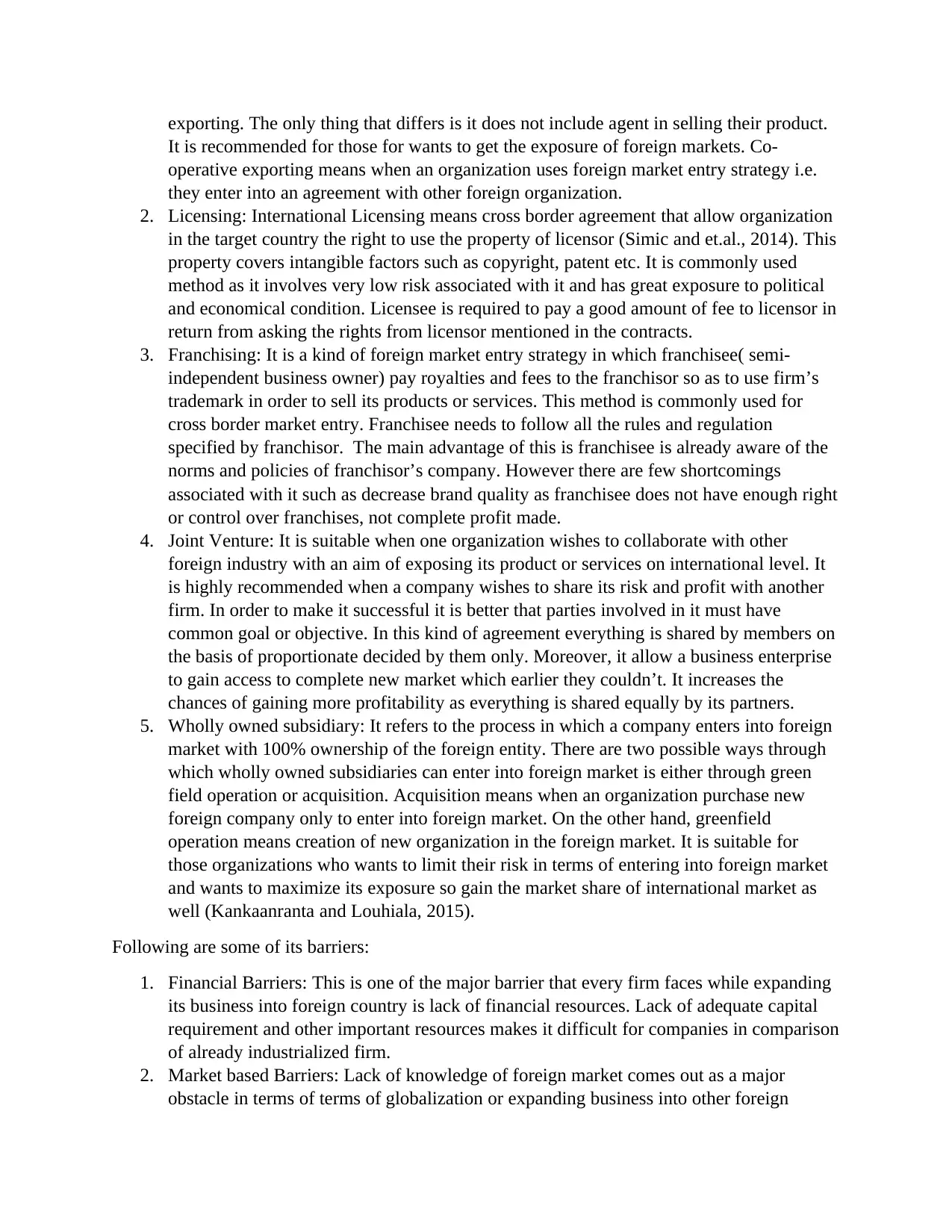
exporting. The only thing that differs is it does not include agent in selling their product.
It is recommended for those for wants to get the exposure of foreign markets. Co-
operative exporting means when an organization uses foreign market entry strategy i.e.
they enter into an agreement with other foreign organization.
2. Licensing: International Licensing means cross border agreement that allow organization
in the target country the right to use the property of licensor (Simic and et.al., 2014). This
property covers intangible factors such as copyright, patent etc. It is commonly used
method as it involves very low risk associated with it and has great exposure to political
and economical condition. Licensee is required to pay a good amount of fee to licensor in
return from asking the rights from licensor mentioned in the contracts.
3. Franchising: It is a kind of foreign market entry strategy in which franchisee( semi-
independent business owner) pay royalties and fees to the franchisor so as to use firm’s
trademark in order to sell its products or services. This method is commonly used for
cross border market entry. Franchisee needs to follow all the rules and regulation
specified by franchisor. The main advantage of this is franchisee is already aware of the
norms and policies of franchisor’s company. However there are few shortcomings
associated with it such as decrease brand quality as franchisee does not have enough right
or control over franchises, not complete profit made.
4. Joint Venture: It is suitable when one organization wishes to collaborate with other
foreign industry with an aim of exposing its product or services on international level. It
is highly recommended when a company wishes to share its risk and profit with another
firm. In order to make it successful it is better that parties involved in it must have
common goal or objective. In this kind of agreement everything is shared by members on
the basis of proportionate decided by them only. Moreover, it allow a business enterprise
to gain access to complete new market which earlier they couldn’t. It increases the
chances of gaining more profitability as everything is shared equally by its partners.
5. Wholly owned subsidiary: It refers to the process in which a company enters into foreign
market with 100% ownership of the foreign entity. There are two possible ways through
which wholly owned subsidiaries can enter into foreign market is either through green
field operation or acquisition. Acquisition means when an organization purchase new
foreign company only to enter into foreign market. On the other hand, greenfield
operation means creation of new organization in the foreign market. It is suitable for
those organizations who wants to limit their risk in terms of entering into foreign market
and wants to maximize its exposure so gain the market share of international market as
well (Kankaanranta and Louhiala, 2015).
Following are some of its barriers:
1. Financial Barriers: This is one of the major barrier that every firm faces while expanding
its business into foreign country is lack of financial resources. Lack of adequate capital
requirement and other important resources makes it difficult for companies in comparison
of already industrialized firm.
2. Market based Barriers: Lack of knowledge of foreign market comes out as a major
obstacle in terms of terms of globalization or expanding business into other foreign
It is recommended for those for wants to get the exposure of foreign markets. Co-
operative exporting means when an organization uses foreign market entry strategy i.e.
they enter into an agreement with other foreign organization.
2. Licensing: International Licensing means cross border agreement that allow organization
in the target country the right to use the property of licensor (Simic and et.al., 2014). This
property covers intangible factors such as copyright, patent etc. It is commonly used
method as it involves very low risk associated with it and has great exposure to political
and economical condition. Licensee is required to pay a good amount of fee to licensor in
return from asking the rights from licensor mentioned in the contracts.
3. Franchising: It is a kind of foreign market entry strategy in which franchisee( semi-
independent business owner) pay royalties and fees to the franchisor so as to use firm’s
trademark in order to sell its products or services. This method is commonly used for
cross border market entry. Franchisee needs to follow all the rules and regulation
specified by franchisor. The main advantage of this is franchisee is already aware of the
norms and policies of franchisor’s company. However there are few shortcomings
associated with it such as decrease brand quality as franchisee does not have enough right
or control over franchises, not complete profit made.
4. Joint Venture: It is suitable when one organization wishes to collaborate with other
foreign industry with an aim of exposing its product or services on international level. It
is highly recommended when a company wishes to share its risk and profit with another
firm. In order to make it successful it is better that parties involved in it must have
common goal or objective. In this kind of agreement everything is shared by members on
the basis of proportionate decided by them only. Moreover, it allow a business enterprise
to gain access to complete new market which earlier they couldn’t. It increases the
chances of gaining more profitability as everything is shared equally by its partners.
5. Wholly owned subsidiary: It refers to the process in which a company enters into foreign
market with 100% ownership of the foreign entity. There are two possible ways through
which wholly owned subsidiaries can enter into foreign market is either through green
field operation or acquisition. Acquisition means when an organization purchase new
foreign company only to enter into foreign market. On the other hand, greenfield
operation means creation of new organization in the foreign market. It is suitable for
those organizations who wants to limit their risk in terms of entering into foreign market
and wants to maximize its exposure so gain the market share of international market as
well (Kankaanranta and Louhiala, 2015).
Following are some of its barriers:
1. Financial Barriers: This is one of the major barrier that every firm faces while expanding
its business into foreign country is lack of financial resources. Lack of adequate capital
requirement and other important resources makes it difficult for companies in comparison
of already industrialized firm.
2. Market based Barriers: Lack of knowledge of foreign market comes out as a major
obstacle in terms of terms of globalization or expanding business into other foreign
⊘ This is a preview!⊘
Do you want full access?
Subscribe today to unlock all pages.

Trusted by 1+ million students worldwide
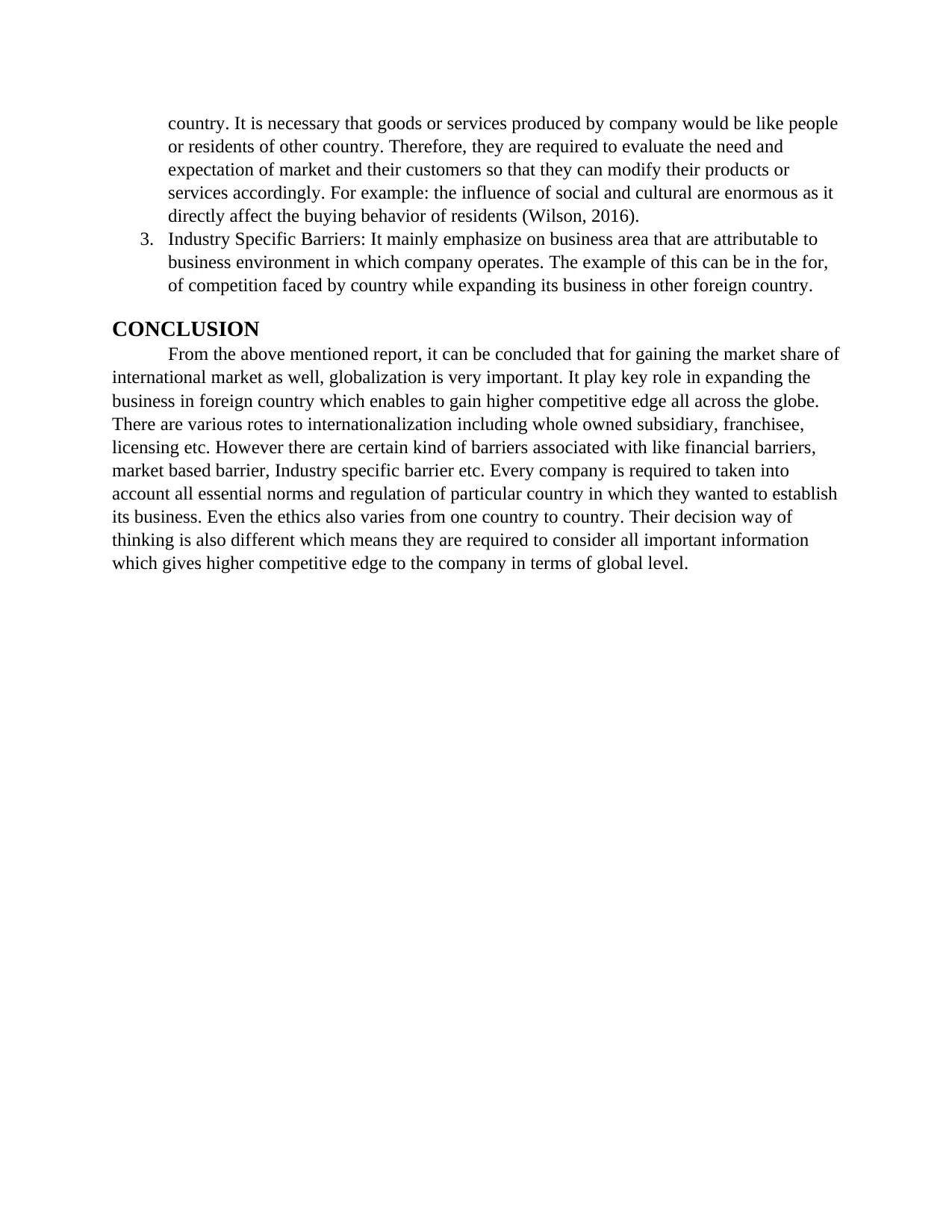
country. It is necessary that goods or services produced by company would be like people
or residents of other country. Therefore, they are required to evaluate the need and
expectation of market and their customers so that they can modify their products or
services accordingly. For example: the influence of social and cultural are enormous as it
directly affect the buying behavior of residents (Wilson, 2016).
3. Industry Specific Barriers: It mainly emphasize on business area that are attributable to
business environment in which company operates. The example of this can be in the for,
of competition faced by country while expanding its business in other foreign country.
CONCLUSION
From the above mentioned report, it can be concluded that for gaining the market share of
international market as well, globalization is very important. It play key role in expanding the
business in foreign country which enables to gain higher competitive edge all across the globe.
There are various rotes to internationalization including whole owned subsidiary, franchisee,
licensing etc. However there are certain kind of barriers associated with like financial barriers,
market based barrier, Industry specific barrier etc. Every company is required to taken into
account all essential norms and regulation of particular country in which they wanted to establish
its business. Even the ethics also varies from one country to country. Their decision way of
thinking is also different which means they are required to consider all important information
which gives higher competitive edge to the company in terms of global level.
or residents of other country. Therefore, they are required to evaluate the need and
expectation of market and their customers so that they can modify their products or
services accordingly. For example: the influence of social and cultural are enormous as it
directly affect the buying behavior of residents (Wilson, 2016).
3. Industry Specific Barriers: It mainly emphasize on business area that are attributable to
business environment in which company operates. The example of this can be in the for,
of competition faced by country while expanding its business in other foreign country.
CONCLUSION
From the above mentioned report, it can be concluded that for gaining the market share of
international market as well, globalization is very important. It play key role in expanding the
business in foreign country which enables to gain higher competitive edge all across the globe.
There are various rotes to internationalization including whole owned subsidiary, franchisee,
licensing etc. However there are certain kind of barriers associated with like financial barriers,
market based barrier, Industry specific barrier etc. Every company is required to taken into
account all essential norms and regulation of particular country in which they wanted to establish
its business. Even the ethics also varies from one country to country. Their decision way of
thinking is also different which means they are required to consider all important information
which gives higher competitive edge to the company in terms of global level.
Paraphrase This Document
Need a fresh take? Get an instant paraphrase of this document with our AI Paraphraser
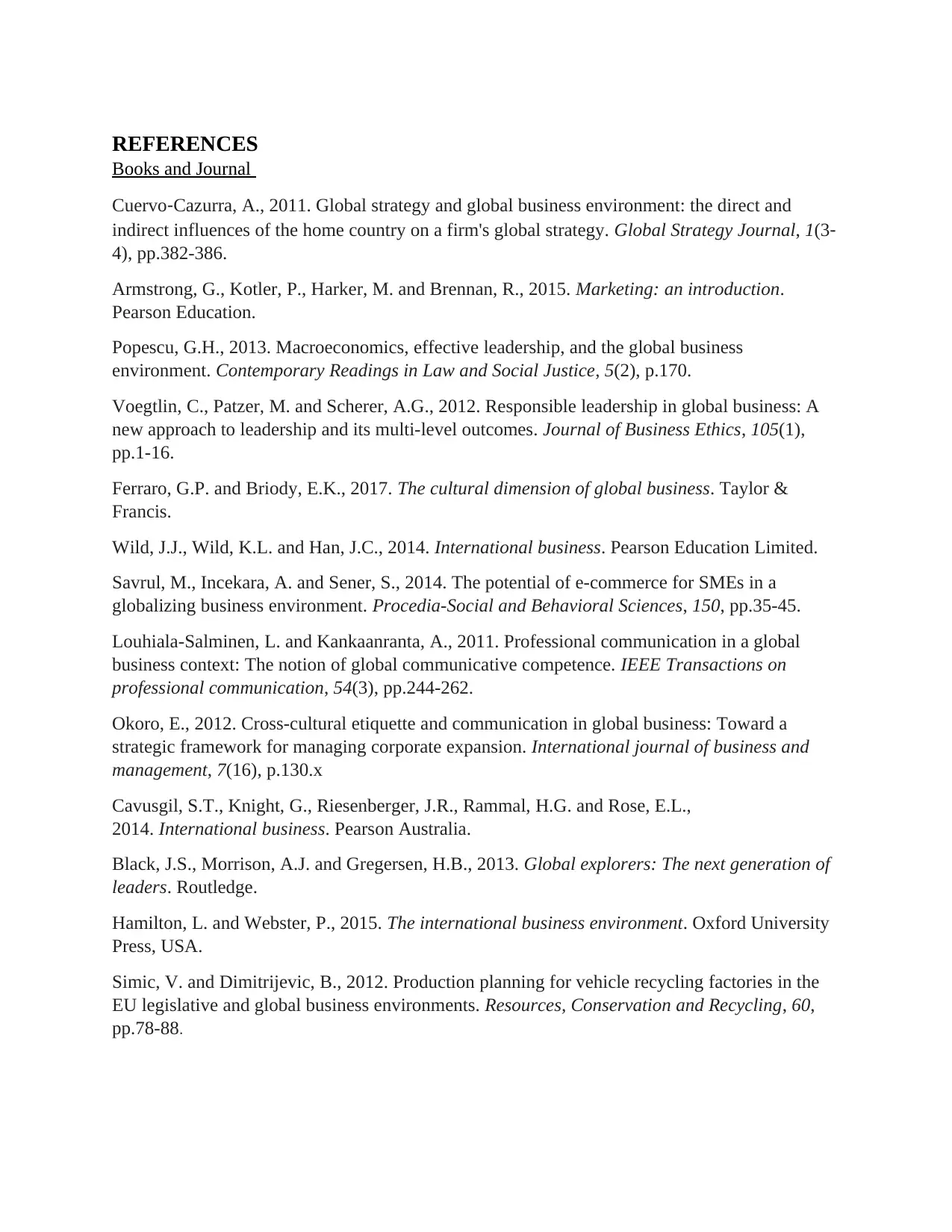
REFERENCES
Books and Journal
Cuervo‐Cazurra, A., 2011. Global strategy and global business environment: the direct and
indirect influences of the home country on a firm's global strategy. Global Strategy Journal, 1(3‐
4), pp.382-386.
Armstrong, G., Kotler, P., Harker, M. and Brennan, R., 2015. Marketing: an introduction.
Pearson Education.
Popescu, G.H., 2013. Macroeconomics, effective leadership, and the global business
environment. Contemporary Readings in Law and Social Justice, 5(2), p.170.
Voegtlin, C., Patzer, M. and Scherer, A.G., 2012. Responsible leadership in global business: A
new approach to leadership and its multi-level outcomes. Journal of Business Ethics, 105(1),
pp.1-16.
Ferraro, G.P. and Briody, E.K., 2017. The cultural dimension of global business. Taylor &
Francis.
Wild, J.J., Wild, K.L. and Han, J.C., 2014. International business. Pearson Education Limited.
Savrul, M., Incekara, A. and Sener, S., 2014. The potential of e-commerce for SMEs in a
globalizing business environment. Procedia-Social and Behavioral Sciences, 150, pp.35-45.
Louhiala-Salminen, L. and Kankaanranta, A., 2011. Professional communication in a global
business context: The notion of global communicative competence. IEEE Transactions on
professional communication, 54(3), pp.244-262.
Okoro, E., 2012. Cross-cultural etiquette and communication in global business: Toward a
strategic framework for managing corporate expansion. International journal of business and
management, 7(16), p.130.x
Cavusgil, S.T., Knight, G., Riesenberger, J.R., Rammal, H.G. and Rose, E.L.,
2014. International business. Pearson Australia.
Black, J.S., Morrison, A.J. and Gregersen, H.B., 2013. Global explorers: The next generation of
leaders. Routledge.
Hamilton, L. and Webster, P., 2015. The international business environment. Oxford University
Press, USA.
Simic, V. and Dimitrijevic, B., 2012. Production planning for vehicle recycling factories in the
EU legislative and global business environments. Resources, Conservation and Recycling, 60,
pp.78-88.
Books and Journal
Cuervo‐Cazurra, A., 2011. Global strategy and global business environment: the direct and
indirect influences of the home country on a firm's global strategy. Global Strategy Journal, 1(3‐
4), pp.382-386.
Armstrong, G., Kotler, P., Harker, M. and Brennan, R., 2015. Marketing: an introduction.
Pearson Education.
Popescu, G.H., 2013. Macroeconomics, effective leadership, and the global business
environment. Contemporary Readings in Law and Social Justice, 5(2), p.170.
Voegtlin, C., Patzer, M. and Scherer, A.G., 2012. Responsible leadership in global business: A
new approach to leadership and its multi-level outcomes. Journal of Business Ethics, 105(1),
pp.1-16.
Ferraro, G.P. and Briody, E.K., 2017. The cultural dimension of global business. Taylor &
Francis.
Wild, J.J., Wild, K.L. and Han, J.C., 2014. International business. Pearson Education Limited.
Savrul, M., Incekara, A. and Sener, S., 2014. The potential of e-commerce for SMEs in a
globalizing business environment. Procedia-Social and Behavioral Sciences, 150, pp.35-45.
Louhiala-Salminen, L. and Kankaanranta, A., 2011. Professional communication in a global
business context: The notion of global communicative competence. IEEE Transactions on
professional communication, 54(3), pp.244-262.
Okoro, E., 2012. Cross-cultural etiquette and communication in global business: Toward a
strategic framework for managing corporate expansion. International journal of business and
management, 7(16), p.130.x
Cavusgil, S.T., Knight, G., Riesenberger, J.R., Rammal, H.G. and Rose, E.L.,
2014. International business. Pearson Australia.
Black, J.S., Morrison, A.J. and Gregersen, H.B., 2013. Global explorers: The next generation of
leaders. Routledge.
Hamilton, L. and Webster, P., 2015. The international business environment. Oxford University
Press, USA.
Simic, V. and Dimitrijevic, B., 2012. Production planning for vehicle recycling factories in the
EU legislative and global business environments. Resources, Conservation and Recycling, 60,
pp.78-88.
1 out of 11
Related Documents
Your All-in-One AI-Powered Toolkit for Academic Success.
+13062052269
info@desklib.com
Available 24*7 on WhatsApp / Email
![[object Object]](/_next/static/media/star-bottom.7253800d.svg)
Unlock your academic potential
Copyright © 2020–2025 A2Z Services. All Rights Reserved. Developed and managed by ZUCOL.




